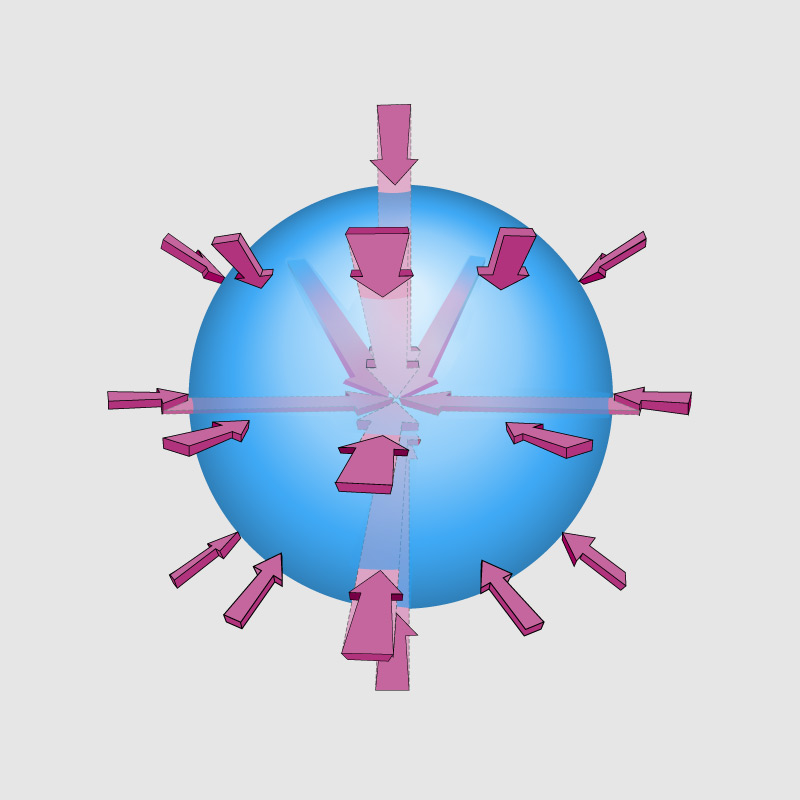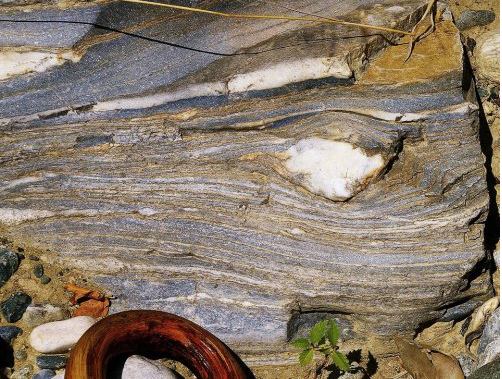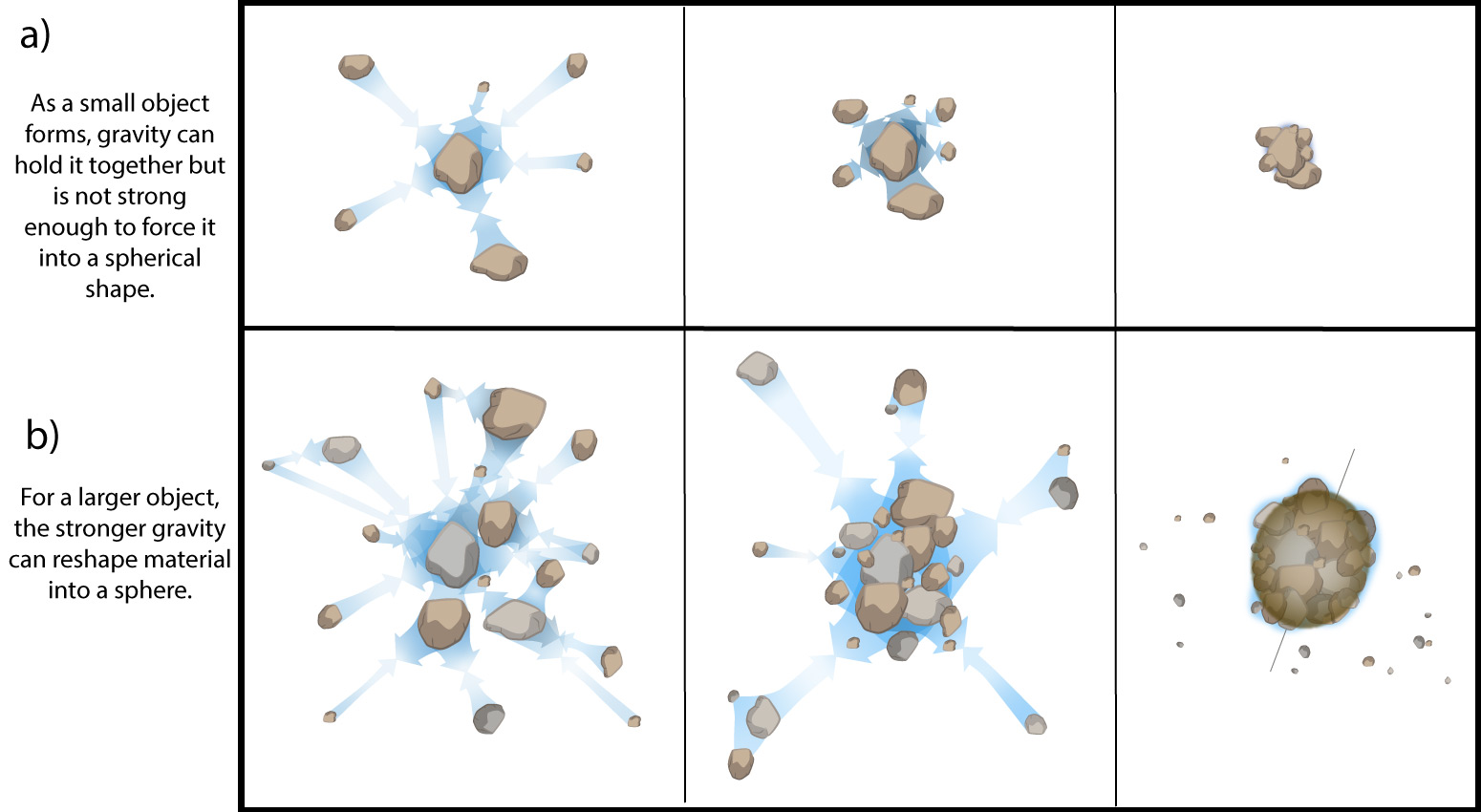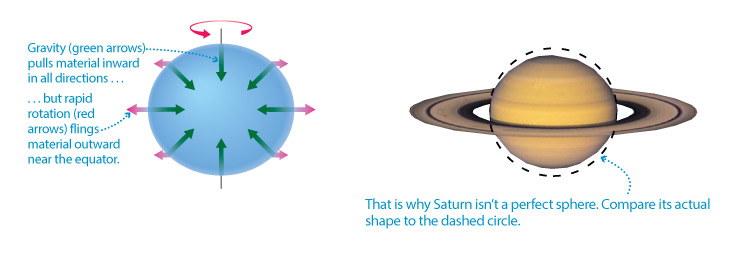We now turn to the third item on our list from the beginning of this section of six key things that gravity does:
Gravity makes Earth and other planets round.
The general reason for this is fairly easy to understand: Gravity always pulls toward a center, and forces that pull toward a center tend to make objects spherical if nothing else gets in the way (Figure 3.28).

This tendency is particularly easy to see by observing soap bubbles or water droplets in space (Figure 3.29). Just as with gravity, the forces holding these bubbles and droplets together create an inward pull that is equal in all directions. Therefore, as long as there are no other forces disturbing them, bubbles and droplets tend to have spherical shapes.


Figure 3.29 (c) - This video shows astronaut Scott Kelly experimenting with a water droplet – in some cases with dyes injected in it – in the International Space Station. Notice that although touching the droplets can make them shake, they take on spherical shapes when they settle down. Credit: NASA.
Of course, sometimes there are other forces involved, and that is why a tendency to become spherical doesn’t always mean than an object will be spherical. You can see this with soap bubbles and the water droplets in the way they sometimes move and distort from a spherical shape. For the solar system, we find a clear pattern related to object sizes (Figure 3.30):
- Small bodies, like asteroids and comets, are not typically round. They can have most any shape, being oblong or even potato-shaped.
- Larger bodies, including all the planets and the Sun, are generally round (spherical).
Why do you think this is? Think about it, and perhaps try the following activity, before you read on.

Activity
Rubber Band Ball
Materials:
- lots of rubber bands
- at least one small round object (such as a marble) and one small cube-shaped object (such as a 6-sided die) to serve as “seeds” to start the ball.
Procedure:
- Using individual rubber bands, stretch them out in different ways and observe the way they exert force. In what direction do these “stretching forces” point? How is this similar to the way the force of gravity pulls?
- Make a rubber band ball around your sphere-shaped seed. What happens to the shape of the ball as it gets larger?
- Now make a rubber band ball around your cube-shaped seed; be sure that you add rubber bands at all orientations (that is, don’t deliberately try to align them with the cubes faces). What happens to the shape of the ball as it gets larger in this case?
- Consider the following claim: “If you make a rubber band ball large enough, it will tend to be spherical no matter what shape object you start with as the seed.” Support or refute this claim with evidence and reasoning.
- Relate your findings to objects of different sizes in the solar system, like those shown in Figure 3.29.
This activity is designed to help students understand how central forces like gravity make planets round. Students make rubber band balls around both spherical and cubic seeds. They’ll see that if the “ball” is small, it will still be generally cubic around the cubic seed. However, as the ball gets larger, it will tend to be round no matter what the shape of the seed. Note: This activity can be a bit time-consuming, so you might help students start it in class and then complete their rubber band balls at home. Alternatively, it is simple enough that you could do it as a “thought experiment” rather than actually taking the time to complete it. Notes for the individual steps:
- The goal here is for students to recognize the forces in a stretched rubber band are pulling toward a point at the center of the rubber band. This is easiest to see if it is stretched into a round shape around all the fingers of your two open hands, since you can feel it pulling your fingers together toward a center. In this sense, the forces are similar to the force of gravity, which also pulls toward a center.
- The ball should start spherical because of the spherical seed, and stay spherical as it gets larger.
- The “ball” will reflect the cube-shape when it has only a few rubber bands stretched around it. But as it gets larger, students will notice that the ball begins to look more round. Note: As indicated in the instructions, it is important that just as gravity acts in all directions, the rubber bands be added at all random orientations. Otherwise, students could choose to orient them in a way that tends to preserve the underlying cubic shape.
- The claim is true. Students should recognize that the central-pulling forces of the rubber bands become dominant as the ball gets larger, making a large rubber band ball spherical no matter what shape seed you begin with.
- Small objects may start with almost any size, but as they get larger, the central-pulling force of gravity tends to make them spherical.
Size and Shape
The key to understanding the pattern of sizes and shapes in our solar system is to think about the forces that can oppose gravity’s tendency to make objects round. The strength of these forces depends primarily on the phase — solid, liquid, or gas — of the material in the object.
Let’s start with the Sun, which is essentially a giant ball of very hot gas. Because gas tends to move freely, it does not resist the force of gravity that tries to shape it into a sphere. That is why the Sun, like other stars, is spherical in shape.
Now consider the largest planets: Jupiter, Saturn, Uranus, and Neptune. Although they are sometimes called “gas giants,” the interiors of these planets are mostly liquid (only their outer layers are gas). Liquid also flows easily, so these planets are also easily shaped into spheres by gravity.
At the other end of the size spectrum, it’s also easy to understand the shapes of small objects like asteroids and comets. These objects are made mostly of solid rock or solid ice, both of which can resist the compression of gravity. Because their small sizes means their gravity is relatively weak, the solid resistance can successfully counter gravity’s tendency to make objects spherical. That is why these objects can have almost any random “potato shape.”
The most challenging cases to understand are objects that are solid but round. These objects include Earth and the other inner planets, a few large moons (including our Moon), and the so-called dwarf planets that include Ceres and Pluto. Given that solid material can resist gravity, and these worlds are made mostly of solid rock or solid ice, how did these worlds end up being round?
Two key processes were involved in the answer.
- Many of these worlds, including Earth, became so hot during early stages of their formation that even rock melted, becoming molten (liquid). During this time, gravity was able to shape the molten material into spheres quite easily.
⇒ Note: As you’ll learn in Chapter 4, a similar idea explains how planets like Earth ended up with dense cores and lower-density mantles and crusts: During the time when their interiors were molten, the denser material sank toward the center while lower density material rose upward. - For worlds that never became hot enough to melt, gravity can still shape them into spheres if they are large enough and enough time passes. In fact, calculations show that gravity will cause any rocky or icy object larger than about 500 kilometers across to become spherical within about 1 billion years. Because our solar system is much older than this (about 4½ billion years old), virtually all objects of this size and larger in the solar system are round.
Regarding the second process above, you might wonder how gravity can ever overcome the resistance of solid rock. The somewhat surprising answer is that even though we often think of rock as the ultimate in strength (“solid as a rock”), over long periods of time solid rock can flow much like a liquid. This type of solid “rock flow” typically takes thousands to millions of years to be noticeable, but you can sometimes find rocks that have clearly flowed in the past. Notice, for example, the “flowing” shape of the layers in the rock shown in Figure 3.31. The fact that rock can flow means that given strong enough gravity and long enough time, even worlds that have always been solid will eventually become spherical in shape. In later chapters, you’ll see that this type of “solid flow” has been very important to Earth’s geological history.

Here is a brief summary of the basic idea behind the pattern of shapes in our solar system:
- Small objects, like most asteroids and comets, have relatively weak gravity. Therefore, even though gravity is pulling toward their centers, it is not strong enough to change the shapes that they formed with. That is why they can have almost any “potato shape” (Figure 3.32a).
- Larger objects have stronger gravity that shapes them into spheres. This happens quickly for objects that are gaseous (like the Sun) or liquid (like the largest planets or smaller planets during their molten stages), but it will eventually happen even for solid objects that are larger than about 500 kilometers in diameter (Figure 3.32b).

Claim-Evidence-Reasoning Discussion
Cubic Planets?
Imagine you are discussing the possibility of life in other solar systems with a friend. Your friend proposes the possibility of a cube-shaped planet orbiting another star. Write a reply to your friend using evidence and reasoning to either support or refute the following claim:
The claim is not reasonable, because as we’ve discussed, objects large enough to be considered “planets” will always tend to be spherical, not cube-shaped. It may be helpful to remind your students that gravity works in the same manner throughout the universe, meaning, it will act the same way on any planetary or stellar body as it does in our solar system. Because gravity is always an inward pulling force, directed toward one center, this implies that all bodies (of sufficient mass/size) will reach a spherical shape. Furthermore, if a cube-shaped planet was formed somehow, it too would eventually even out into a spherical shape, given enough time. The corners of the cube would eventually be pulled in until gravity was affecting an equal force on the entire surface of the once cube-shaped planet.
Wow Factor
The longest laboratory experiment ever done.
Coming Soon
Equatorial Bulging
By itself, gravity would make large objects perfectly round. However, objects in space are generally rotating, and as you know from what you feel when riding a merry-go-round, rotation tends to fling material outward. For planets, rotation tends to fling material outward near their equators (Figure 3.33a). The result is that rotating planets tend to have an equatorial bulge.
The amount of equatorial bulge depends on both the strength of gravity and the rotation rate: Stronger gravity tends to make a bulge less prominent, while faster rotation tends to make it more prominent. In our solar system, the most extreme case of equatorial bulge occurs for Saturn, which has a shape that is noticeably “squashed” at its poles compared to a perfect sphere (Figure 3.33b).

For Earth, the equatorial bulge is small enough that our planet looks almost perfectly round from space. Still, the bulge is measurable: Earth is about 43 kilometers larger in diameter at the equator (equatorial diameter = 12,756 km) than at the poles (polar diameter = 12,713 km).